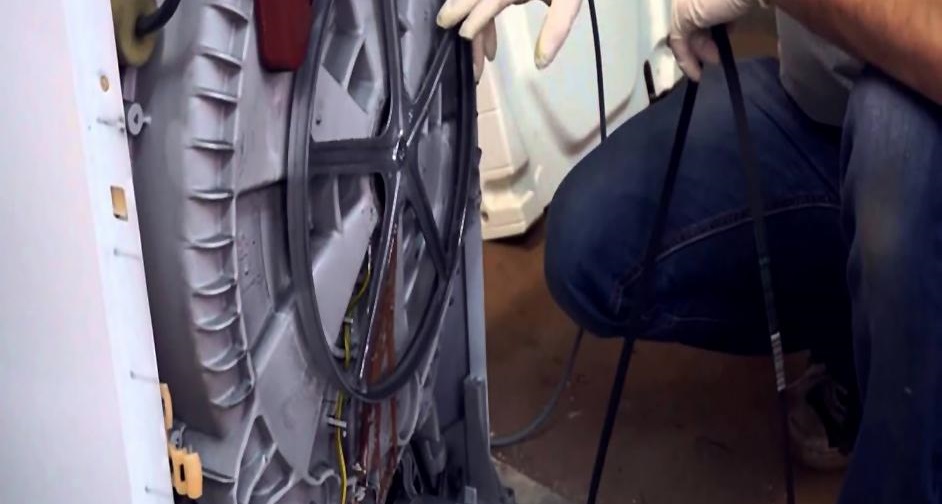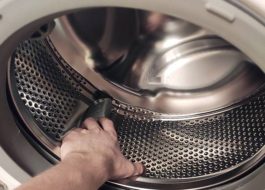The drum does not spin in a Siemens washing machine
 It is quite simple to guess that a Siemens washing machine does not spin the drum: the machine suddenly slows down and refuses to continue the cycle. Sometimes the cylinder gets stuck and you can’t turn it even by hand. In any case, the laundry remains dirty, and the planned washing is disrupted. To restore the functionality of the washing machine, you must immediately begin diagnostics and identify the “culprit” of the stop. Let's take a closer look at what to check and how to fix it.
It is quite simple to guess that a Siemens washing machine does not spin the drum: the machine suddenly slows down and refuses to continue the cycle. Sometimes the cylinder gets stuck and you can’t turn it even by hand. In any case, the laundry remains dirty, and the planned washing is disrupted. To restore the functionality of the washing machine, you must immediately begin diagnostics and identify the “culprit” of the stop. Let's take a closer look at what to check and how to fix it.
Origin of this malfunction
It is impossible to determine by eye why the drum on Siemens does not rotate. Several problems at once can lead to a machine stop, and the number of possible failures depends on the model of the machine, the installed components and even the country of assembly. But, as a rule, sudden braking of the cylinder is caused by the following typical breakdowns:
- the drum is jammed by a solid object that has fallen inside;
- the drive has gone wrong (the drive belt has fallen off or the pulley has deteriorated);
- the electric motor is broken (does not start at all or does not accelerate to the specified speed);
- the drum doors suddenly opened (on Siemens with vertical loading);
- There were problems with the control board (individual triacs burned out or the module failed completely).

The list of reasons that can suddenly slow down a drum is far from complete. Modern Siemens washing machines have complex electronic “stuffing”: the operation of the cylinder is coordinated and controlled by many components, microelements and sensors. The slightest failure in the system will lead to broken contact and stopping the machine.
On Siemens washing machines, the drum does not rotate if the motor breaks down, the doors open, a foreign object gets stuck, or there are problems with the drive or control board.
Vague “symptoms” also complicate diagnosis. The signs of breakdowns are very similar, and without consistent checking of all possible culprits, it is very difficult to localize the problem. Ideally, you need to contact a service center, but if you wish, you can identify the failure and fix it yourself. The main thing is to act immediately and according to the instructions. Below we will consider situations in which the drum does not rotate at all. If the cylinder unwinds, albeit chaotically, then the list of reasons will be significantly expanded.
Problems with the drive part
If the washer suddenly stops the drum, then first of all the drive belt is checked - it is responsible for transmitting the impulse from the motor to the drum shaft. If the rubber band breaks or falls off, the cylinder stops rotating. To adjust the drive, it is necessary to return the “ring” to its place.
It’s worse if the belt breaks constantly, more than three times every 6 months. In such a situation, it is not enough to simply return the rubber band to its place: the condition of the rim and pulley must be assessed. Perhaps the wheel was deformed and the ring stretched. Then you will need to repair or replace components.
Before making a “diagnosis”, you need to inspect the belt. The instructions on what to do are as follows:
- disconnect Siemens from power supply and water supply;
- turn the equipment with the back panel forward;
- unscrew the “back” by loosening the corresponding bolts;
- inspect the pulley and assess the condition of the belt.
Is the belt on the pulley? This means that the problem with the stopped drum is not in the drive. If the rubber has fallen off, you should carefully inspect it and the wheel for defects.If there is no damage or stretching, you can return the rim to its place, otherwise you will have to replace it with a new one.
The new drive belt is selected taking into account the serial number of the Siemens washing machine.
If the belt slipped the first time and remained intact, then it’s too early to sound the alarm. It is enough to pull the elastic band back and start the test cycle. It’s another matter if the leak occurs repeatedly: then you need to move on to the rubber element or pulley repair. In the second case, we proceed like this:
- fix the wheel motionless by holding a screw or stick between the blades;
- pour WD-40 lubricant over the central bolt and wait 15-40 minutes for the product to “work”;
- Use a suitable ratchet to loosen the bolt (do not apply force, otherwise the thread will break);
- remove the wheel from the shaft;

- we purchase a new pulley;
- We fix the new pulley on the shaft by tightening the central screw.
The drive belt is put on the new pulley. First, we put the rubber band on the motor shaft, and then we pull it onto the drum pulley. The new elastic band is stretched very tightly, be prepared for this.
Something foreign is stuck in the tank
The reason for the sudden stop of the drum may be a foreign object stuck in the machine. Keys, coins and hairpins that get into the washer can fall into the tank, get caught in the hole in the tank and cause the shaft to jam. As a result, Siemens will grind to a halt. Drum jamming is a serious matter. Attempts to unwind the cylinder manually or restart the wash will lead to serious consequences: mechanical damage and deformation of both containers.
Before washing, check the pockets of items loaded into the drum - forgotten items can cause jams and clog the drain.
To free the drum, you need to remove the stuck object from the tank.The easiest way to do this is through the hole in the heating element, especially if the heater is located at the back wall. What should I do?
- Disconnect Siemens from the power supply.
- Shut off the water supply.
- Drain the water through the emergency drain or garbage filter (if the washing machine stops during the washing process).
- Detach the back wall from the housing.
- Find a heating element under the tank, or rather, its rounded chip with connected wires.
- Take a photo of the location of the wires.
- Disconnect the terminals.

- Loosen the central fastener.
- Remove the heating element (if it is stuck, use WD-40).
- Through the resulting hole, remove the stuck object using your hand or a wire bent into a “hook”. At the same time, remove all the debris accumulated at the bottom of the tank.
If the heater on Siemens is located near the front panel, then it is recommended to remove the stuck object through the drain hole. It is enough to put the machine on its side, unscrew the pan, release the drain pipe and catch the “lost thing” with your hand.
Drum flaps in a top-loading machine
Owners of Siemens with vertical loading may encounter another reason for the drum stopping - flaps opening during washing. The doors swing open and get stuck, stopping the entire mechanism. You cannot cope with this breakdown on your own; you need to call a specialist. If the “vertical” stops with a clang, then it is necessary:
- urgently de-energize the machine;
- collect spilled water;
- call customer service.
Siemens vertical models may stop during washing due to the drum flaps opening.
Attempting to return the drum to the desired position on your own may result in damage to the cylinder or tank. Only a specialist can disassemble the washing machine, remove the jam and return all the elements to their places.
Let's pay attention to the engine
The drum also stops if there are problems with the engine. The motor does not accelerate, and the shaft, like the cylinder, remains motionless. More often than not, the collector motor “fails,” since these devices have several typical breakdowns:
- worn out electric brushes;
- peeled lamellas;
- winding break.

Diagnosing and repairing a motor is not an easy task. First, you need to remove the device from the washing machine body. Secondly, test it for serviceability using a multimeter. It is important to act sequentially: first check the general condition of the engine, then measure the length of the carbon brushes, inspect the lamellas and “ring” the winding for breakdown.
Replacement components are selected depending on the serial number of the existing Siemens washing machine.
If you suspect an engine breakdown, it is recommended to contact a service center. If you can replace the electric brushes yourself, then professionals should test the motor itself, grind the lamellas and do the winding. Sometimes repairs are useless - only replacing the engine.
Electronic failure
It’s worse if a failure in the control board caused the drum to slow down. Such a breakdown is more difficult to diagnose and more expensive to repair. The fact is that self-repair is not recommended here - a specialist should inspect and “ring” the electronic unit. There are several compelling arguments for contacting a service center:
- To diagnose and flash the board, special equipment is required;
- the work will require skill, experience and a lot of time, since you will have to sequentially check each element of the module;
- one wrong move can lead to permanent breakage of the board, and it is expensive.

It is almost impossible to immediately understand that the problem is in the board.Both the entire module and the element responsible for communication with the motor or drive may burn out. A millimeter “gap” in the track or one burnt-out triac will interrupt the circuit: the node will not receive the command and will remain motionless. Having detected a lack of reaction, the system will automatically stop operating the washing machine.
The cost of a new control board can reach 5-25 thousand rubles, depending on the model of the Siemens washing machine.
It is strongly not recommended to deal with the control board yourself. If no problems are identified with the drive, motor and drum, then it’s time to contact a service center.
Interesting:
1 reader comment





















Thank you